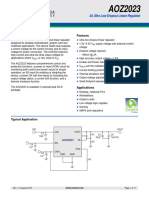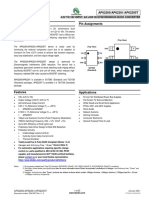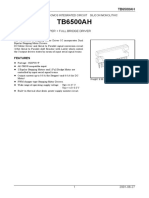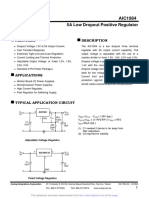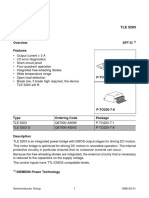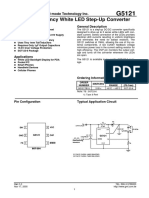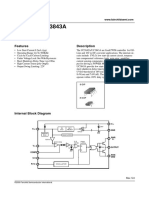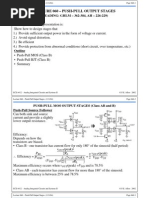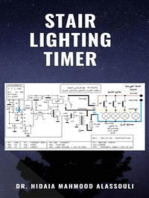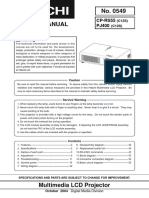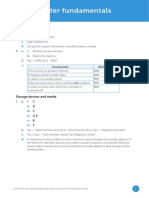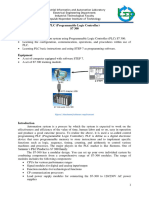Very Low Dropout 3.0 Amp Regulator With Enable: Power Management Features Description
Very Low Dropout 3.0 Amp Regulator With Enable: Power Management Features Description
Uploaded by
mitusharmaCopyright:
Available Formats
Very Low Dropout 3.0 Amp Regulator With Enable: Power Management Features Description
Very Low Dropout 3.0 Amp Regulator With Enable: Power Management Features Description
Uploaded by
mitusharmaOriginal Title
Copyright
Available Formats
Share this document
Did you find this document useful?
Is this content inappropriate?
Copyright:
Available Formats
Very Low Dropout 3.0 Amp Regulator With Enable: Power Management Features Description
Very Low Dropout 3.0 Amp Regulator With Enable: Power Management Features Description
Uploaded by
mitusharmaCopyright:
Available Formats
SC1566
Very Low Dropout
3.0 Amp Regulator With Enable
POWER MANAGEMENT
Description Features
The SC1566 is a high performance positive voltage u 350mV dropout @ 3A
regulator designed for use in applications requiring very u Adjustable output from 1.2V to 4.8V
low dropout voltage at up to 3 Amps. Since it has u 2.5V and 1.8V options (5 pin parts also adjustable
superior dropout characteristics compared to regular externally using resistors)
LDOs, it can be used to supply 2.5V on motherboards or
u Over current and over temperature protection
2.8V on peripheral cards from the 3.3V supply thus
u Enable pin
allowing heat sink size reduction or elimination.
Additionally, the five pin versions of SC1566 have an u 10µA quiescent current in shutdown
enable pin, to further reduce power dissipation while shut u Low reverse leakage (output to input)
down. The SC1566 provides excellent regulation over u Full industrial temperature range
variations in line, load and temperature. u TO-220 and TO-263 packages
The SC1566 is available as three terminal fixed output Applications
voltage and five terminal fixed or adjustable output u Battery powered systems
voltage devices with enable. Two package options are u Motherboards and notebook computers
available: TO-263 and TO-220.
u Peripheral cards
u Network cards
u Set top boxes
Typical Application Circuits(1)(2) u Medical equipment
U1
SC1566I5T-2.5
VIN 1 5
VIN VO VO = See equation below
2 4
ENABLE EN GND ADJ R1
3 1.200 (R1+ R2)
VO = Volts
C1 C2 R2
R2
U1
SC1566I5T-2.5
1 5
VIN VIN VO VO = 2.5V
2 4
ENABLE EN GND ADJ
C1 C2
3
U1
SC1566IT-1.8
1 3
VIN VIN VO VO = 1.8V
GND Notes:
C1
2
C2
(1) Maximum VO setpoint for 1.8V parts = 5.4V
(2) This device is designed to operate with
ceramic input and output capacitors
Revision 1, January 2001 1 www.semtech.com
SC1566
POWER MANAGEMENT
Absolute Maximum Ratings
Parameter Sy mbol Max U nits
Input Voltage VIN 5.5 V
Power D i ssi pati on PD Internally Li mi ted W
Thermal Resi stance Juncti on to Ambi ent
SC 1566IM (TO-263) q JA 60 °C /W
SC 1566IT (TO-220) 50
Thermal Resi stance Juncti on to C ase
SC 1566IM (TO-263) q JC 3 °C /W
SC 1566IT (TO-220) 3
Operati ng Ambi ent Temperature Range TA -40 to +85 °C
Operati ng Juncti on Temperature Range TJ -40 to +150 °C
Storage Temperature Range TSTG -65 to +150 °C
Lead Temperature (Solderi ng) 10 Sec. TLEAD 300 °C
ESD Rati ng (Human Body Model) V ESD 2 kV
Electrical Characteristics
Unless specified: VEN = VIN. Adjustable Option (VADJ > VTH(ADJ)): VIN = 2.2V to 5.5V and IO = 10µA to 3A.
Fixed Options (VADJ = GND): VIN = (VO + 0.7V) to 5.5V and IO = 0A to 3A. Values in bold apply over the full operating temperature range.
Parameter Sy mbol Test C onditions Min Ty p Max U nits
VIN
Supply Voltage Range VIN 2.2 5.5 V
Qui escent C urrent IQ VIN = 3.3V 0.75 1.75 mA
VIN = 5.5V, VEN = 0V 10 35 µA
VO
Output Voltage(1) VO VIN = VO + 0.7V, IO = 10mA -1% VO +1% V
(Internal Fi xed Voltage) -2% +2%
Li ne Regulati on(1) REG(LINE) VIN = (VO + 0.25V) to 5.5V, IOUT = 10mA 0.035 0.3 %
Load Regulati on(1) REG(LOAD) VIN = VO + 0.7V 0.2 0.4 %
D ropout Voltage(1)(2) VD IO = 10mA 1 5 mV
10
IO = 500mA 75 100 mV
150
ã 2001 Semtech Corp. 2 www.semtech.com
SC1566
POWER MANAGEMENT
Electrical Characteristics (Cont.)
Unless specified: VEN = VIN. Adjustable Option (VADJ > VTH(ADJ)): VIN = 2.2V to 5.5V and IO = 10µA to 3A.
Fixed Options (VADJ = GND): VIN = (VO + 0.7V) to 5.5V and IO = 0A to 3A. Values in bold apply over the full operating temperature range.
Parameter Sy mbol Test C onditions Min Ty p Max U nits
VO (C ont.)
D ropout Voltage(1)(2) IO = 1.5A 200 300 mV
400
IO = 3A 350 450 mV
600
Mi ni mum Load C urrent(3) IO VIN = VO + 0.7V 1 10 µA
C urrent Li mi t ICL 3.0 4.5 6.5 A
AD J
Reference Voltage(1) VREF VIN = 2.2V, VADJ = VOUT, IO = 10mA 1.188 1.200 1.212 V
1.176 1.224
Adjust Pi n C urrent(4) IADJ VADJ = VREF 10 50 nA
Adjust Pi n Threshold(5) VTH(ADJ) 0.10 0.20 0.40 V
EN
Enable Pi n C urrent IEN VEN = 0V, VIN = 3.3V 1.5 10 µA
Enable Pi n Threshold VIH VIN = 3.3V 1.8 V
VIL VIN = 3.3V 0.4
Ov er Temperature Protection
Hi gh Tri p level THI 175 °C
Hysteresi s THYST 10 °C
Notes:
(1) Low duty cycle pulse testing with Kelvin connections required.
(2) Defined as the input to output differential at which the output voltage drops to 1% below the value
measured at a differential of 0.7V.
(3) Required to maintain regulation. Voltage set resistors R1 and R2 are usually utilized to meet this
requirement. Adjustable versions only.
(4) Guaranteed by design.
(5) When VADJ exceeds this threshold, the Sense Select switch disconnects the internal feedback chain from
the error amplifier and connects VADJ instead.
ã 2001 Semtech Corp. 3 www.semtech.com
SC1566
POWER MANAGEMENT
Pin Configurations Ordering Information
D ev ice(1) P ackag e
SC 1566 5-PIN
Versions SC 1566IM-X.X.TR TO-263-3(3)
Pin Function SC 1566I5M-X.X.TR(2) TO-263-5(3)
1 VIN SC 1566IT-X.X TO-220-3(4)
2 EN SC 1566I5T-X.X(2) TO-220-5(4)
TO-263-5 3 GND Notes:
(1) Where -X.X denotes voltage options. Available
4 AD J
voltages are: 2.5V and 1.8V.
5 VO (2) Output voltage can be adjusted using external
resistors, see Pin Descriptions below.
TAB IS GND (3) Only available in tape and reel packaging. A reel
TO-220-5 contains 800 devices.
(6) Only available in tube packaging. A tube contains 50
devices.
SC 1566 3-PIN
Versions
Block Diagram
Pin Function
1 VIN
2 GND
TO-263-3 3 VO
TAB IS GND
Note:
(1) 3-pin versions are fixed output
voltage only.
TO-220-3
* 5 lead versions only
Pin Descriptions
Pin N ame Pin D esciption
AD J Thi s pi n, when grounded, sets the output voltage to that set by the i nternal feedback resi stors. If external
feedback resi stors are used, the output voltage wi ll be (See Appli cati on C i rcui ts on page 1):
1.200 (R1 + R2)
VO = Volts
R2
EN Enable Input. Pulli ng thi s pi n below 0.4V turns the regulator off, reduci ng the qui escent current to a fracti on of
i ts operati ng value. The devi ce wi ll be enabled i f thi s pi n i s left open. C onnect to VIN i f not bei ng used.
GND Reference ground. Use the tab (electri cally connected to GND ) for heatsi nki ng.
VIN Input voltage. For regulati on at full load, the i nput to thi s pi n must be between (VO + 0.7V) and 5.5V. Mi ni mum
VIN = 2.2V.
VO Thi s pi n i s the power output of the devi ce.
ã 2001 Semtech Corp. 4 www.semtech.com
SC1566
POWER MANAGEMENT
Typical Characteristics
Dropout Voltage vs. Output Current Dropout Voltage vs. Junction
vs. Junction Temperature Temperature vs. Output Current
500 500
150°C
450 450
IO = 3A
400 400
25°C
350 350
0°C
300 -40°C 300 IO = 1.5A
VD (mV)
VD (mV)
250 250
200 200
150 150
IO = 0.5A
100 100
50 50
0 0
0.0 0.5 1.0 1.5 2.0 2.5 3.0 3.5 -50 -25 0 25 50 75 100 125 150
IO (A) TJ (°C)
Output Voltage (2.5V) vs. Junction Output Voltage (2.5V) vs. Junction
Temperature vs. Output Current Temperature vs. Output Current
2.550 2.550
VIN = 3.2V VIN = 5.5V
2.540 2.540
2.530 2.530
2.520 2.520
2.510 2.510
IO = 10mA IO = 10mA
VO (V)
VO (V)
2.500 2.500
2.490 2.490
IO = 3A IO = 3A
2.480 2.480
2.470 2.470
2.460 2.460
2.450 2.450
-50 -25 0 25 50 75 100 125 150 -50 -25 0 25 50 75 100 125 150
TJ (°C) TJ (°C)
Reference Voltage vs. Junction Reference Voltage vs. Junction
Temperature vs. Output Current Temperature vs. Output Current
1.225 1.225
VIN = 2.2V VIN = 5.5V
1.220 1.220
1.215 1.215
1.210 1.210
1.205 1.205
VREF (V)
VREF (V)
IO = 10mA IO = 3A
1.200 1.200
1.195 1.195
IO = 3A IO = 10mA
1.190 1.190
1.185 1.185
1.180 1.180
1.175 1.175
-50 -25 0 25 50 75 100 125 150 -50 -25 0 25 50 75 100 125 150
TJ (°C) TJ (°C)
ã 2001 Semtech Corp. 5 www.semtech.com
SC1566
POWER MANAGEMENT
Typical Characteristics (Cont.)
Quiescent Current vs. Off-State Quiescent Current vs.
Junction Temperature Junction Temperature
700 12
VIN = 3.3V VIN = 5.5V
690
10
680
670
8
IQ(OFF) (µA)
660
IQ (µA)
650 6
640
4
630
620
2
610
600 0
-50 -25 0 25 50 75 100 125 150 -50 -25 0 25 50 75 100 125 150
TJ (°C) TJ (°C)
Applications Information
Introduction External voltage selection resistors (5-pin parts): the
use of 1% resistors, and designing for a current flow
The SC1566 is intended for applications such as ³ 10µA is recommended to ensure a well regulated
graphics cards where high current capability and very low output (thus R2 £ 120kW).
dropout voltage are required. It provides a very simple,
low cost solution that uses very little pcb real estate and Thermal Considerations
typically does not require a heatsink. Additional features
include an enable pin to allow for a very low power The power dissipation in the SC1566 is approximately
consumption standby mode, and a fully adjustable equal to the product of the output current and the input
output (5-pin versions). to output voltage differential:
Component Selection PD ≈ (VIN − VOUT ) • I O
Input capacitor: a 4.7µF or 10µF ceramic capacitor is The absolute worst-case dissipation is given by:
recommended. This allows for the device being some
distance from any bulk capacitance on the rail. PD ( MAX ) = (VIN ( MAX ) − VOUT ( MIN ) )• I O ( MAX ) + VIN ( MAX ) • I Q ( MAX )
Additionally, input droop due to load transients is reduced,
improving load transient response. Additional capacitance For a typical scenario, VIN = 3.3V ± 5%, VOUT = 2.8V and
may be added if required by the application. IO = 2.5A, therefore:
Output capacitor: a minimum bulk capacitance of 22µF, VIN(MAX) = 3.465V, VOUT(MIN) = 2.744V and IQ(MAX) = 1.75mA,
along with a 0.1µF ceramic decoupling capacitor is
recommended. Increasing the bulk capacitance will Thus PD(MAX) = 1.81W.
improve the overall transient response. The use of
multiple lower value ceramic capacitors in parallel to Using this figure, and assuming TA(MAX) = 85°C, we can
achieve the desired bulk capacitance will not cause calculate the maximum thermal impedance allowable to
stability issues. Although designed for use with ceramic maintain TJ £ 150°C (see page 7):
output capacitors, the SC1566 is extremely tolerant of
output capacitor ESR values and thus will also work
comfortably with tantalum output capacitors.
ã 2001 Semtech Corp. 6 www.semtech.com
SC1566
POWER MANAGEMENT
Applications Information (Cont.)
This should be achievable for the TO-263 package using
R TH ( J − A )( MAX ) =
(T
J( MAX ) − TA (MAX ) )
=
(150 − 85 ) = 36 °C / W pcb copper area to aid in conducting the heat away from
PD (MAX ) 1 .81
the device, such as a large (~2 squ. inch) pad connected
R TH ( J − C )( MAX ) = 3 °C / W and R TH ( C − S ) = 0 °C / W , to the tab of the device. Internal ground/power planes
therefore R TH ( S − A )( MAX ) = 33 °C / W and air flow will also assist in removing heat. For higher
power dissipations it may be necessary to use a small
heatsink and the TO-220 package.
Outline Drawing - T0-263-3
Minimum Land Pattern - TO-263-3
ã 2001 Semtech Corp. 7 www.semtech.com
SC1566
POWER MANAGEMENT
Outline Drawing - TO-263-5
Minimum Land Pattern - TO-263-5
ã 2001 Semtech Corp. 8 www.semtech.com
SC1566
POWER MANAGEMENT
Outline Drawing - TO-220-3
Outline Drawing - TO-220-5
Contact Information
Semtech Corporation
Power Management Products Division
652 Mitchell Rd., Newbury Park, CA 91320
Phone: (805)498-2111 FAX (805)498-3804
ã 2001 Semtech Corp. 9 www.semtech.com
This datasheet has been downloaded from:
www.DatasheetCatalog.com
Datasheets for electronic components.
You might also like
- SC1531 Semtech CorporationDocument11 pagesSC1531 Semtech Corporation94430s19684No ratings yet
- LT3990 Demo Circuit 1471 Quick Start Guide LT3990 62V, 350ma Step-Down Regulator With 2.5 A Quiescent Current and Integrated DiodesDocument3 pagesLT3990 Demo Circuit 1471 Quick Start Guide LT3990 62V, 350ma Step-Down Regulator With 2.5 A Quiescent Current and Integrated DiodesDmitryNo ratings yet
- FDC6325L Integrated Load Switch: FeaturesDocument4 pagesFDC6325L Integrated Load Switch: FeaturesTamo NekoNo ratings yet
- FDC6329L Integrated Load Switch: FeaturesDocument4 pagesFDC6329L Integrated Load Switch: FeaturesranelcomNo ratings yet
- FDC6326L Integrated Load Switch: General Description FeaturesDocument5 pagesFDC6326L Integrated Load Switch: General Description FeaturesИван АлексиевNo ratings yet
- FDC6330L FairchildDocument5 pagesFDC6330L FairchildluisNo ratings yet
- PV PanelDocument17 pagesPV PanelMuhammad RiazNo ratings yet
- AP2205Document16 pagesAP2205alialpasha2No ratings yet
- Datasheet AME8815Document17 pagesDatasheet AME8815ALFONZO DANIELNo ratings yet
- AOZ2023PIDocument11 pagesAOZ2023PIjuliocunachiNo ratings yet
- AL8862QDocument17 pagesAL8862QIvo MatosNo ratings yet
- FDR8521LDocument4 pagesFDR8521Lprabhat007gubraniNo ratings yet
- AP62200/AP62201/AP62200T: 4.2V To 18V Input, 2A Low Iq Synchronous Buck ConverterDocument24 pagesAP62200/AP62201/AP62200T: 4.2V To 18V Input, 2A Low Iq Synchronous Buck ConverterAarsol AdvanceNo ratings yet
- Adm202e - Adm1181a (RS232)Document12 pagesAdm202e - Adm1181a (RS232)SERVICE WEBNo ratings yet
- TA8409SDocument12 pagesTA8409SLeal LealNo ratings yet
- INPAQ Transient Voltage Suppressor TVLST2304BD0 Specification A0Document8 pagesINPAQ Transient Voltage Suppressor TVLST2304BD0 Specification A0Isaac CostaNo ratings yet
- TB6500 PDFDocument18 pagesTB6500 PDFJavier CuraNo ratings yet
- TLE7209 R InfineonDocument16 pagesTLE7209 R Infineonmobil benerNo ratings yet
- AP62400 AP62401 Rev1-2 Jun2023Document20 pagesAP62400 AP62401 Rev1-2 Jun2023Vinicius BorbaNo ratings yet
- Aic1084-33ce Regulador 3.3Document7 pagesAic1084-33ce Regulador 3.3VictorManuelBernalBlancoNo ratings yet
- 3-A DC Motor Driver TLE 5203: SPT IcDocument18 pages3-A DC Motor Driver TLE 5203: SPT IcJavier CuraNo ratings yet
- Tle5203 Motor Driver PDFDocument18 pagesTle5203 Motor Driver PDFJavier CuraNo ratings yet
- Ic Driver LCD HP G5121 5121M PDFDocument9 pagesIc Driver LCD HP G5121 5121M PDFBudi PrayitnoNo ratings yet
- Acer Al1916w Psu-Inverter dt830Document55 pagesAcer Al1916w Psu-Inverter dt830LuisNo ratings yet
- DatasheetDocument14 pagesDatasheetsamaya egNo ratings yet
- 3-Channel Differential Line Driver Ic - VXDocument11 pages3-Channel Differential Line Driver Ic - VXAlphaNo ratings yet
- 3842a DatasheetDocument8 pages3842a DatasheetVịnh DemoNo ratings yet
- Flasher, 30 M Shunt, Pilot Lamp To GND or V U2043B: FeaturesDocument10 pagesFlasher, 30 M Shunt, Pilot Lamp To GND or V U2043B: FeaturesVladimirNo ratings yet
- Stanley Electric 22.5 W Electronic Lighting Ballast, 26.4 VDocument6 pagesStanley Electric 22.5 W Electronic Lighting Ballast, 26.4 Vstraw manNo ratings yet
- 3A Ultra Low Dropout Linear Regulator: General DescriptionDocument11 pages3A Ultra Low Dropout Linear Regulator: General DescriptionIgha Intan PermataNo ratings yet
- TVL ST23 04 Ad0Document9 pagesTVL ST23 04 Ad0coulsonpfilNo ratings yet
- 5A Low Dropout Positive Adjustable Regulator: Features DescriptionDocument7 pages5A Low Dropout Positive Adjustable Regulator: Features DescriptionZiller Ricardo Camilo AlegreNo ratings yet
- APL5932A/B/C/D: Features General DescriptionDocument21 pagesAPL5932A/B/C/D: Features General DescriptionAku KudupiknikNo ratings yet
- Design Principle Circuit Descripition: A) B) C) D) E) F) G) H) I)Document33 pagesDesign Principle Circuit Descripition: A) B) C) D) E) F) G) H) I)AJAY VISHNU M SNo ratings yet
- SSC9512SDocument2 pagesSSC9512SSamaro RodriguezNo ratings yet
- SY8286Document8 pagesSY8286ce604No ratings yet
- Apu8836 3Document6 pagesApu8836 3dataNo ratings yet
- General Description Features: 28V/10A Synchronous Ezbuck RegulatorDocument15 pagesGeneral Description Features: 28V/10A Synchronous Ezbuck RegulatorРоман ІкалюкNo ratings yet
- Pulse-Width-Modulation Control Circuits Az7500EDocument13 pagesPulse-Width-Modulation Control Circuits Az7500EMy shop Cool100% (1)
- AP1509Document12 pagesAP1509Андрей ОлененкоNo ratings yet
- uPI Confidential: 3A Ultra Low Dropout Linear RegulatorDocument13 pagesuPI Confidential: 3A Ultra Low Dropout Linear RegulatorLEONNo ratings yet
- AOZ3015AIDocument14 pagesAOZ3015AIIcomNo ratings yet
- AT1526 GlobalMixed ModetechnologyDocument2 pagesAT1526 GlobalMixed ModetechnologyFafa MangstabNo ratings yet
- DatasheetDocument17 pagesDatasheetAlaa Ibrahem AhmedNo ratings yet
- UC3842ANDocument8 pagesUC3842ANLourencosud SudNo ratings yet
- AL8860EV2 User GuideDocument8 pagesAL8860EV2 User GuideHans ClarinNo ratings yet
- 34 W 4-Channel BTL Power IC: DescriptionDocument15 pages34 W 4-Channel BTL Power IC: DescriptionHugo Alexander RicoNo ratings yet
- TB6674FAG ToshibaDocument18 pagesTB6674FAG ToshibalucianassisNo ratings yet
- TDA7266LDocument7 pagesTDA7266LChiranjit JenaNo ratings yet
- L5972DDocument10 pagesL5972DLuis Enrique De los Santos FarfánNo ratings yet
- L060 Push Pull (2UP)Document10 pagesL060 Push Pull (2UP)srikanthkmsNo ratings yet
- 3843ANDocument8 pages3843ANinfosolutionNo ratings yet
- 5v and 12v 1a Output Power Supply With Onboard Transformer 1Document1 page5v and 12v 1a Output Power Supply With Onboard Transformer 1Sundar KrishNo ratings yet
- Ec48324 FV PDFDocument11 pagesEc48324 FV PDFАлександрNo ratings yet
- UPc491 Switching RegulatorDocument21 pagesUPc491 Switching Regulatorjj_301039No ratings yet
- Dual Channel, Ultra-Low Resistance Load Switch: General Description ApplicationsDocument10 pagesDual Channel, Ultra-Low Resistance Load Switch: General Description ApplicationsПавелNo ratings yet
- EM5106 ExcellianceMOSDocument10 pagesEM5106 ExcellianceMOSSib Repair CenterNo ratings yet
- JBGGDocument9 pagesJBGGvs15231523No ratings yet
- General Description Features: 28V/10A Synchronous Ezbuck RegulatorDocument15 pagesGeneral Description Features: 28V/10A Synchronous Ezbuck RegulatorholinsunNo ratings yet
- KH 8700Document16 pagesKH 8700mitusharmaNo ratings yet
- 1605261Document8 pages1605261mitusharmaNo ratings yet
- Bap31u - 6in1 BoardDocument16 pagesBap31u - 6in1 BoardmitusharmaNo ratings yet
- 16808-1 BottomDocument1 page16808-1 BottommitusharmaNo ratings yet
- M72-DVT: PreliminaryDocument87 pagesM72-DVT: PreliminarymitusharmaNo ratings yet
- NM A931Document98 pagesNM A931mitusharmaNo ratings yet
- Hitachi CP RS55 Service Manual PDFDocument70 pagesHitachi CP RS55 Service Manual PDFmitusharmaNo ratings yet
- Practical 12thDocument7 pagesPractical 12thkumarnareshNo ratings yet
- William Stallings Computer Organization and Architecture 7 Edition System BusesDocument91 pagesWilliam Stallings Computer Organization and Architecture 7 Edition System BusesassadNo ratings yet
- Reg. No.: Psna College of Engineering and Technology, Dindigul-624622 Department of EceDocument1 pageReg. No.: Psna College of Engineering and Technology, Dindigul-624622 Department of EceshasiNo ratings yet
- Numerical Problems-Module 2 and 3Document2 pagesNumerical Problems-Module 2 and 3nidhi patelNo ratings yet
- Contention Based - PAMASDocument2 pagesContention Based - PAMASmurlak37100% (1)
- ADSP21992 LitemanDocument63 pagesADSP21992 LitemanJaime Andres Aranguren CardonaNo ratings yet
- Lab 1 - Week2Document29 pagesLab 1 - Week2splokbovNo ratings yet
- Unit 2 Reading Efficiently by Reading Intelligently: Learning Strategy: Reading AcademicallyDocument4 pagesUnit 2 Reading Efficiently by Reading Intelligently: Learning Strategy: Reading AcademicallyFranco FloresNo ratings yet
- DBMS-Introduction To Database Management Systems NotesDocument36 pagesDBMS-Introduction To Database Management Systems NotesKomal Ramteke100% (2)
- Common Motherboard, Cpu and Ram ProblemsDocument10 pagesCommon Motherboard, Cpu and Ram ProblemsSocorro FloresNo ratings yet
- Lect3 Shift Registers PDFDocument10 pagesLect3 Shift Registers PDFParveen MalikNo ratings yet
- U4257bm NDocument1 pageU4257bm NAlexej BegenchewNo ratings yet
- A Practical Application of ARM Cortex M3Document19 pagesA Practical Application of ARM Cortex M3Kang YiNo ratings yet
- Mca 1 Sem Computer Organization and Architecture Kca105 2022Document1 pageMca 1 Sem Computer Organization and Architecture Kca105 2022kimog66911No ratings yet
- Csec It Work Book Answers 01Document4 pagesCsec It Work Book Answers 01Jada CameronNo ratings yet
- Modul PLC SIEMENSDocument5 pagesModul PLC SIEMENSWahjue AjhiieNo ratings yet
- тексти для ІІТDocument21 pagesтексти для ІІТthegreatryuk2005No ratings yet
- Service Manual: HCD-GRX50/R770/RXD7Document71 pagesService Manual: HCD-GRX50/R770/RXD7Oscar CalaguaNo ratings yet
- R23 System Disassembly: - Table of ContentsDocument32 pagesR23 System Disassembly: - Table of Contentsmarito72No ratings yet
- Stock Disponible Televentas Lima 23.04.2024Document339 pagesStock Disponible Televentas Lima 23.04.2024Franchezca CustodioNo ratings yet
- Insulated Gate Bipolar Transistor With Ultrafast Soft Recovery DiodeDocument16 pagesInsulated Gate Bipolar Transistor With Ultrafast Soft Recovery DiodeSalah Al-AbsiNo ratings yet
- Internet Technologies Chapter 1: Introduction To InternetDocument15 pagesInternet Technologies Chapter 1: Introduction To Internetfreedom mutepfeNo ratings yet
- Ashwin Pajankar - Raspberry Pi Image Processing Programming - With NumPy, SciPy, Matplotlib, and OpenCV-Apress (2022)Document254 pagesAshwin Pajankar - Raspberry Pi Image Processing Programming - With NumPy, SciPy, Matplotlib, and OpenCV-Apress (2022)Luis Fraire100% (1)
- Milestones in The History of Electronic CommunicationDocument2 pagesMilestones in The History of Electronic CommunicationChillie Bronzal Ullamot100% (2)
- Wcdma Kpi Optimization: Presented by Ahmed AzizDocument64 pagesWcdma Kpi Optimization: Presented by Ahmed AzizCesar Ivan Alvear Vega100% (5)
- Documentation - Cisco UCS PDFDocument29 pagesDocumentation - Cisco UCS PDFvenkateshNo ratings yet
- Thank You: First Steps With Your New INSEVIS-PLC For Choosing INSEVIS ProductsDocument8 pagesThank You: First Steps With Your New INSEVIS-PLC For Choosing INSEVIS ProductsubaiNo ratings yet
- Modeling ISFET Microsensor and ISFET-based Microsystems: A ReviewDocument14 pagesModeling ISFET Microsensor and ISFET-based Microsystems: A ReviewOussama El BouadiNo ratings yet
- Sesion - 11 - Timer 2 y PWMDocument22 pagesSesion - 11 - Timer 2 y PWMMafa GuillénNo ratings yet
- Yealink VC Products and SolutionDocument34 pagesYealink VC Products and SolutionddhNo ratings yet









